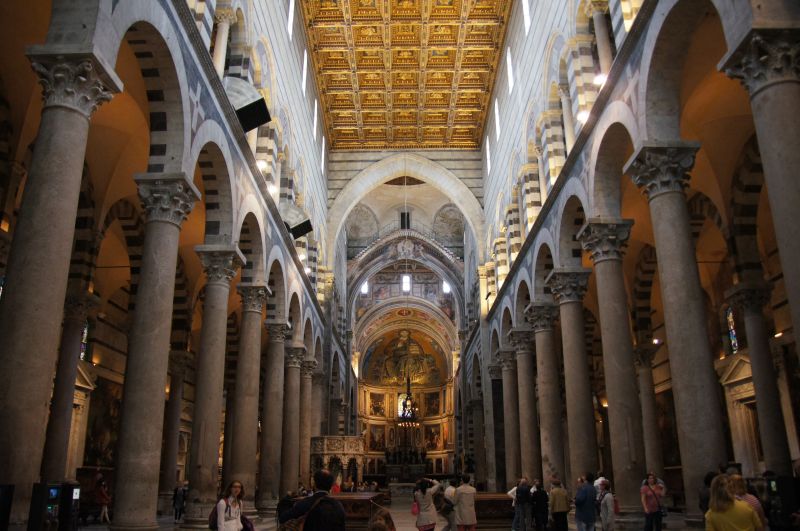

Qui il popolo di Dio, nato nel Battesimo, è convocato perché sotto la guida dell'Arcivescovo Giovanni Paolo Benotto, cammini orientato dalla Parola e nutrito dai Sacramenti, verso Cristo principio e fine
The Cathedral
Solemn and luminous, the interior is characterised by its imposing granite pillars with sculpted capitals in Corinthian style and by its lively two-coloured marble facing, with black and white bands of marble, repeating the external decorations of the outer façade, adding colour to the undulating motif of the arcades along the nave and the women's gallery. An extremely rich wealth of works of art is to be found througout the interior which is rendered event more majestic by the beautiful marble floor, its cross vault including a large section of the original cosmatesque decoration, and by the sumtuous coffered ceiling, that was rebuilt after the 1595 fire by the Florence-based Atticciati work-shop. The display of masterpieces begins [...] on the counter-façade where, to the side of the main door, underneath a balcony also known as “Poggiolo delle reliqui”, can be found the funeral monuments of the archbishops Francesco Frosini, Matteo Rinuccini, Giuliana de' Medici and Francesco Guidi, all works of considerable importance by 17th- and 18th-century sculptors. In 1523, the sculptural features of the Cathedral, further damaged by the 1595 fire, underwent wide internal refurbishments that continued over the following centuries. Continuing down the lateral aisles, the two arms of the transpect and the smaller aisles at the sides of the choir-stalls, there follows a succession of marble altars, nine of which were sculpted in the 16th century by the Versilian-born artist Stagio Stagi. [...] Equally rich is the wealth of paintings and mosaics decorating the Cathedral, whose oldest surviving evidence, which is still in place, is the small 13th-century painting on a wooden tablet known as Madonna di sotto gli organi, on the altar of the same name. The oldest fresco, a large Virgin with Child, that was brought to light in 1958 at the top of the triumphal arch, attributed to Maestro di San Torpé, dates back to somewhere between the late 13th century and the early 14th century. [...] Of much greater importance is the wonderful mosaic work in the apse, with Cristo in maestrà tra la Madonna e San Giovanni Evangelista, the only documented work by Cimabue, who created the figure of Saint John. [...] A wide cycle of paintings on wood and canvas winds along the walls of the two aisles and the apsidal tribune, providing a summa of Tuscan-Roman pointing between the late Renaissance and the first signs of neoclassicism. Amongst these stand out masterpieces by Andrea Del Sarto and Domenico Beccafumy [...]. Finally, dense with reminiscences of the more ostentatious Roman baroque style is the bright, dazzling Assumption of the Virgin and Saints, frescoed in the cupola, in the form of th evault of heaven, by Orazio and Girolamo Rimialdi [...].
This work by Matthew Blissett is licensed under a Creative Commons Attribution-ShareAlike 3.0 Unported License.
Permissions beyond the scope of this license may be available at http://matt.blissett.me.uk/contact/.